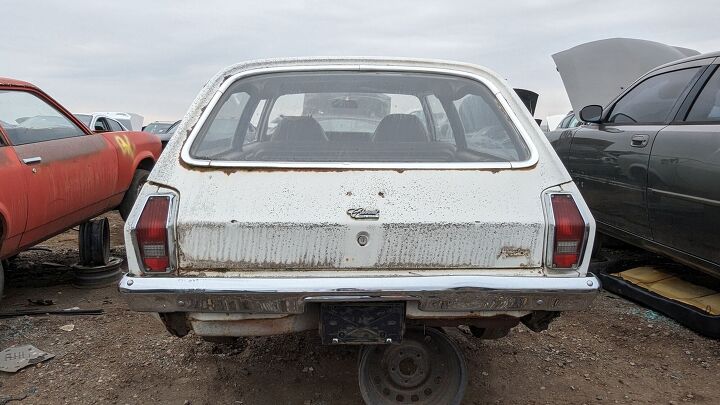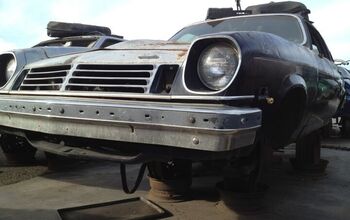Junkyard Find: 1972 Chevrolet Vega Kammback

General Motors built more than two million Chevy Vegas, and they were everywhere on the roads of North America through about the second half of the 1980s. The Vega has been a junkyard rarity for decades now, but I just found six early Vegas all within a couple of rows of one another in a Denver self-service yard. Today, we'll look at the only wagon of that group.
I'm going to keep linking to Aaron Severson's excellent article about the Vega's history here because you should read it all the way through before we continue. Then you'll want to look at the joyously optimistic factory brochure for the Vega's first model year, followed immediately by the chapter of John DeLorean's memoir that covers his version of the Vega/Lordstown fiasco.
Since I started documenting interesting discarded vehicles in 2007, I've written about nine Vegas: a 1972 hatchback, a 1973 hatchback with V8 swap, a 1975 hatchback, a 1975 Cosworth, a 1975 GT hatchback, a 1976 notchback, a 1976 Cosworth, a 1979 Monza Wagon and a 1979 Pontiac Sunbird Wagon.
The official final model year for the Vega was 1977, but the wagon version stayed in production with Monza and Sunbird badges through 1979.
The Chevrolet Monza and its siblings (the 1975-1980 Oldsmobile Starfire, Buick Skyhawk and Pontiac Sunbird) were based on the Vega's H-Body platform, as we all know, but GM didn't even bother to put non-Vega snouts on the 1978-1979 Monza and Sunbird wagons. Therefore, you could say that the true Chevy Vega was sold for the 1971 through 1977 or 1979 model years, depending on how strict you want to be.
The Vega, though a fairly conventional front-engine/rear-drive subcompact that was a bit bigger than the imports (like its bitter Ford rival, the Pinto), had some interesting technological advances and looked good with its Camaro-ish nose. It should have been a gigantic sales hit for a decade, but instead turned into an image-tarnishing nightmare for GM despite a few strong years in the showroom.
The engine was this 140-cubic-inch (2.3-liter) SOHC straight-four, which seems Pinto-like (though the Pinto didn't get a 2.3-liter engine until the 1974 model year). However, it has an unusual combination of aluminum block and iron cylinder head, and the cylinders didn't have iron liners (which saved GM $8 per car, or about $61 in 2023 dollars).
Such cost-cutting measures took their toll on the Vega's image right away. The fenders rusted instantly, and the engine had inadequate cooling that would cause it to blow head gaskets (or worse) under not-so-harsh driving conditions that a primitive but sturdy Chevy Nova wouldn't even notice. The list goes on, but the heavily publicized recalls started early and then just kept coming into the middle 1970s.
Poisonous GM internal politics coupled with labor strife at the Vega's Lordstown assembly plant didn't help. What did help, though, was the Yom Kippur War and resulting OPEC oil embargo in the fall of 1973. Gas lines and sustained high fuel prices had American car shoppers looking for fuel-sipping small cars as never before.
Like the later Chevrolet Citation, the Vega should have been a triumph for The General, ensuring more decades of the kind of sales dominance that had made GM fear—with good reason—a federally-imposed antitrust breakup during the 1950s and 1960s.
Perhaps the difference between what the Vega could have been and how it turned out is especially frustrating for me because I came of driving age in the early 1980s, a time in which many of my peers were being issued hand-me-down five- or 10-year-old Vegas. I drove, rode in, and worked on lots of those Vegas, and they were hard-pressed to operate for a solid week without some showstopping problem that left you stranded.
That said, maybe a lightly-used Vega was just not the kind of car to be entrusted to teenagers with terrible driving and wrenching skills. I have friends whose families relied on Vegas for all their daily-driving needs all through the 1970s and deep into the 1980s. Some of them race a Vega in the 24 Hours of Lemons and still have plenty of affection for the little Pinto fighter (though the race car has an Iron Duke powertrain swap out of an S-10, because they're not masochistic enough to put a Vega 140 engine on a road course).
The MSRP on the 1972 Vega Kammback wagon was $2,285, which comes to about $16,995 after inflation.
The base transmission was this three-on-the-floor manual, a configuration that remained available in new American-market cars until 1981. A two-speed Powerglide automatic and four-speed manual were available at extra cost (but with 80 horsepower in a 2,333-pound wagon, the tall-first-gear Powerglide condemned the '71 Vega's driver to a life of driving misery).
The fact that this car showed up with five other Vegas at the same time in a single boneyard suggests that a Vega enthusiast's personal hoard collection was liquidated. All six of them are full of decades of leaf litter and rodent poop, and several have mid-1970s-vintage 23-channel CB radios, suggesting that none had moved under their own power for three or four decades.
This yard had nearly a dozen Dodge Omnis and Plymouth Horizons at the same time, a couple of years back. You never know what you'll find at the junkyard!
Why do Vegas smile? Because they're happy cars. Would a sad car have a license plate reading WHOO-P?
For '72, Chevrolet offered three sizes of station wagon plus the Suburban and the Sportvan.
Who wants just another little car?
Your neighbors will crowd around your new Vega wagon.
[Images: The Author]
Become a TTAC insider. Get the latest news, features, TTAC takes, and everything else that gets to the truth about cars first by subscribing to our newsletter.

Murilee Martin is the pen name of Phil Greden, a writer who has lived in Minnesota, California, Georgia and (now) Colorado. He has toiled at copywriting, technical writing, junkmail writing, fiction writing and now automotive writing. He has owned many terrible vehicles and some good ones. He spends a great deal of time in self-service junkyards. These days, he writes for publications including Autoweek, Autoblog, Hagerty, The Truth About Cars and Capital One.
More by Murilee Martin
Latest Car Reviews
Read moreLatest Product Reviews
Read moreRecent Comments
- ChristianWimmer It might be overpriced for most, but probably not for the affluent city-dwellers who these are targeted at - we have tons of them in Munich where I live so I “get it”. I just think these look so terribly cheap and weird from a design POV.
- NotMyCircusNotMyMonkeys so many people here fellating musks fat sack, or hodling the baggies for TSLA. which are you?
- Kwik_Shift_Pro4X Canadians are able to win?
- Doc423 More over-priced, unreliable garbage from Mini Cooper/BMW.
- Tsarcasm Chevron Techron and Lubri-Moly Jectron are the only ones that have a lot of Polyether Amine (PEA) in them.
















































Comments
Join the conversation
I had a neighbor who owned a yellow 1971 Vega sedan. It was her first new car, and by 1975, the front fenders had rusted out (no inner fenders) along with the bottom of the windshield, and most of the rear fenders behind the wheels were gone. The first engine blew up with 12k and the replacement ran roughly.
One day, her husband and his friend Mark were in the apartment lot, in front of the Vega, when Mary came out. She asked them, What are you two up to? Mark answered, We're watching your car rust."
The rear end of the Vega Kammback has a very close resemblance to the rear end of a Pinto. If Ford and GM had industrial spies, they were bringing back useless information.